Belgium dominant but just manage to get one point
The Belgium national team have had quite an impressive journey since Roberto Martinez’s arrival. 3-0 (Cyprus), 4-0 (Bosnia and Herzegovina), 6-0 (Gibraltar) and 8-1 (Estonia). They have had an outstanding start of this qualification rounds. The previous Swansea, Wigan (FA Cup winner) and Everton coach is well-known for his tactical approach where he tries to get his teams to control the ball as much as they can by pass, move and have a good positional structure. Martinez has received a lot of praise through his coaching career so far, but his last season in Everton ended up in a big failure where he got sacked at the end of last year’s campaign.
Martinez has used a 3-4-2-1/3-2-4-1 formation most of his time in charge of Belgium but has tried a 4-2-3-1 as well. For the Greece game, both Hazard and De Bruyne missed this game and there was an obvious lack of creativity through midfield against a deep defending Greece this night.
Greece’s defensive approach with aggressive defending in the half space
Greece came to this game with one intention – keep a clean sheet with a minimum risk approach. Manolas, Papastathopoulos, Tzavelas created a solid wall in front of Kapino. They where always connected to each other, and when they had the chance they changed their zonal defending to an aggressive zonal marking, when Belgium tried to operate in the half-space, to give Belgium no time for combinations or time to get on the half turn and thread balls forward to Lukaku.
Papastathopoulos in the middle of the back three positioned himself tight to Lukaku who stayed in a central position stretching it throughout the whole game without any space to run in behind. With Lukaku stationed central it allowed the lateral centre-backs (Manolas and Tzavelas) to go in all the way tight to Mertens and Nainggolan in the half-space in a successful way, giving Belgium no time to create combinations and were still able to play 2v1 against Lukaku. Greece usually overloaded their right side defensively with an aim of shutting down Carrasco coming in with his right foot and at the same time trie to manage Mertens operating in Belgium’s left half space where he can threat the goal with shots. Mertens had a free role moving from side to side with license to find space both central as well as he moved all the way giving width. Here you can see some examples where Belgium tried to get an advantage in the half-space, but Greece managed this very well being aggressive but still had good numbers defending 4v3 against Lukaku, Carrasco and Chadli.
Belgium interchange in advanced midfield – or the lack of
Carrasco – Mertens – Nainggolan – Chadli created an advanced midfield four with Witsel and Fellaini behind them. Because of Belgium’s dominance they drove Greece so far back the pitch, Carrasco and Chadli ended up giving high width like wingers in a 4-3-3, rather than giving support to the lateral defenders in build-up like wing-backs. Belgium struggled to move the Greece players enough out of their defensive block over 90 minutes to win this game. The best chance they created came from a header of Fellaini in the 12th minute – this time Mertens managed to suck the left-sided lateral centre-back Tzavelas out of his back five just to move outside to a wing with Chadli moved in the pitch they created behind Tzavelas.
This kind of rotation didn’t happen too often considering the huge number of possession spells Belgium had so high up the pitch. Greece had no problem to keep their compactness and they defended their box very successfully. With Witsel and Fellaini in midfield Belgium lacked to break lines in midfield either with a dribble to get behind that first line of pressing. That left Belgium with few options/variations. The build-up had to go through their centre-backs with only two options, either wide or a longer/deeper pass in to half-space. The three most common passing combinations were between the back three players and Alderweireld – Chadli.
0-0 at halftime without any huge goalscoring chance for any of the teams, Greece came out to the second half with new energy, and they tried to get something of an positive start, and so they did. Mitroglou showed great composure when he was 1v1 against Courtois in the Belgium goal putting Greece in the lead. Fair? Definitely not. Unfair? Not really but the Greeks stayed compact and kept the energy load very low in the first half because of good compactness. They continued to threat the Belgium defensive line with runs for first 5-10 minutes of the second half as you can see on the pictures below.
Tachtsidis got a second booking in the 65th minute, giving Belgium a great chance to put even greater pressure on the Greece defense. Same minute as the red card, Martinez made his first sub with Fellaini leaving the field to get replaced by Dembele. Right or wrong I’m not sure, but at that time of the game I could see a huge benefit of having Fellaini still on the pitch to attack crosses in the box, like the two chances he had in the first half which actually were Belgium’s two best chances up to that point. Belgium kept pushing Greece back even further towards their own goal but when it was 11v11 they didn’t manage to penetrate central zones as much as they would like to do creating goalscoring chances even if Carrasco started to attack the inside space more now with greater space to attack. Just before the 90 minute mark, Lukaku finally got the equalizer showing great strength holding his defender away to get his shot on target.
Thoughts
The hiring of Roberto Martinez will hopefully turn out to be a great signing. With most of the players stationed in Premier League clubs he already has a clear vision of his players’ weaknesses and strengths. Martinez has a clear tactical philosophy that will show benefits over time but already it looks like the team is ready to take the next step that Wilmots never managed to do before he had to leave. The stats and the game against Greece showed that Belgium is moving in the right direction even when they just got one point. I think Belgium will increase the non-verbal understanding of their positional play over time and tactical flexibility will give them a good chance to compete no matter against which opposition they will play.
With Witsel and Fellaini starting the game in midfield, Belgium had obvious issues to break lines from midfield area with a dribble or a qualitative pass breaking line behind that first line of pressure. This left Belgium build-up go through their centre-backs to go either wide or a longer pass in to half-space without any real chance to open up and play combinations because of good pressure. Lukaku stretched the game but got fairly passive watching the game more so than got involved.
Tactical structure to gain advantages wide
I will present some pictures of possibilities to destabilize a defensive block like the one Greece put up in this game. So its not necessarily criticism against Martinez if there are any Belgium fans out there reading this. Some key points for this is like always, where and how can you get an numerical advantage on the pitch or 1v1 situations wide with dribblers that can beat their man attacking the byline.
Interchange Chadli-Mertens
This example is like the one presented above, when Belgium created their highest xG chance in the first half with Fellaini’s header. With this rotation with Chadli – Mertens interchanging they gave Tzavelas a picking up problem in the half-space. Most of the time he followed Mertens all the way and quit so he could drop back in his zone when the ball was away. But because Chadli quickly moved inside this time he got outnumbered 1v2 in the half-space. When Mertens moved outside he was still the closest player to Alderweireld on the ball. This gave Belgium the advantage suddenly playing a 3v2 down the right side.
Bring the centreback out of positions – attack zone 14
Again this happened in the game but not that often. Lukaku is an unquestionable goal machine but he lacks technical attributes to be a reliable link-up player throughout his career even if there’s been small improvements during the years at Everton. What Belgium did well here is that they bypassed Greece’s lateral centre-back when he came into the half-space and attacked the blindside of him with a third-man run concept.
This bit of play happened in the 21st minute, when they managed to use Lukaku as a combination player dragging centre-backs away and allowing midfield runners to attack space that got opened up and create a disorganized defense.
Use lateral centre-back as an advance midfielder overloading width
With no space in the centre there (because of Greece’s compactness), there is a need to have a numerical advantage wide but still able to keep numbers central to open up wide areas. I’ll show an example. Greece had high numbers defensively with a back three, two holders and two advanced midfielders against Fellaini and Witsel when the ball was in Belgium’s back three. To destabilize this it’s necessary for the lateral centre-backs – Vertonghen and Alderweireld – to be brave and bring the ball out from the back with composure and quality. If they position themselves to deep they will struggle to give any numerical advantage down the sides.
I will show these two examples depending how Alderweireld positioning himself on the ball. In the first picture, he is not threatening any space leaving Greece to stay in comfortable positions while, in the second picture, when he drives forward with the ball he quickly gives the Greece team a problem going from a 4v4 situation to a 3v4. So in the second picture, Belgium gain advantage because of the position of the ball is closer to the goal. Now the Greece holder needs to protect the space in front of their defenders, with Nainggolan and Mertens operating there at same time. This gives Belgium the opportunity to be more aggressive wide to either get behind the defenders with through-balls for potential runners or 1v1 or cutbacks.
Now with Alderweireld higher up, there are three potential runners to get in behind depending where the ball is. It could be Alderweireld playing it wide and sprinting into the gap, like it is shown in the picture, to get the ball back, or he gives Chadli a 1v1 situation attracting the left-sided centre-back to follow him or even a potential space opens up for Mertens in the half-space.
Written by Swedish analyst @Fussballaddict.



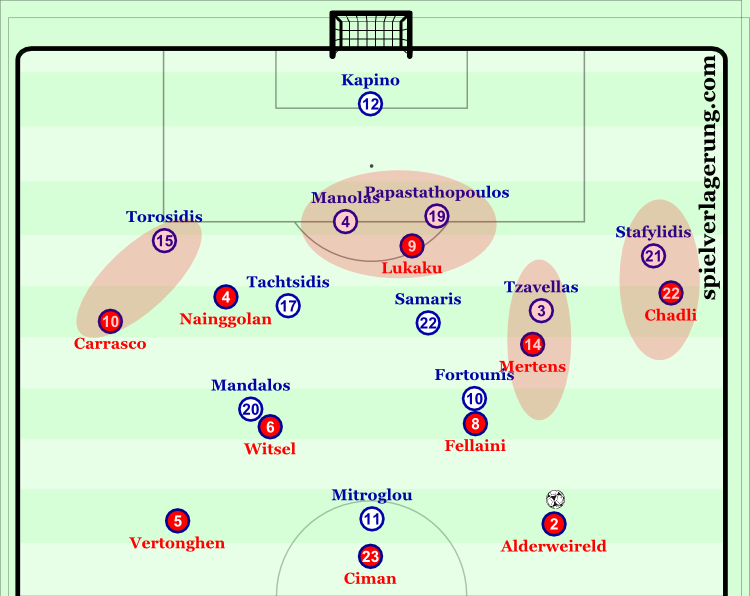
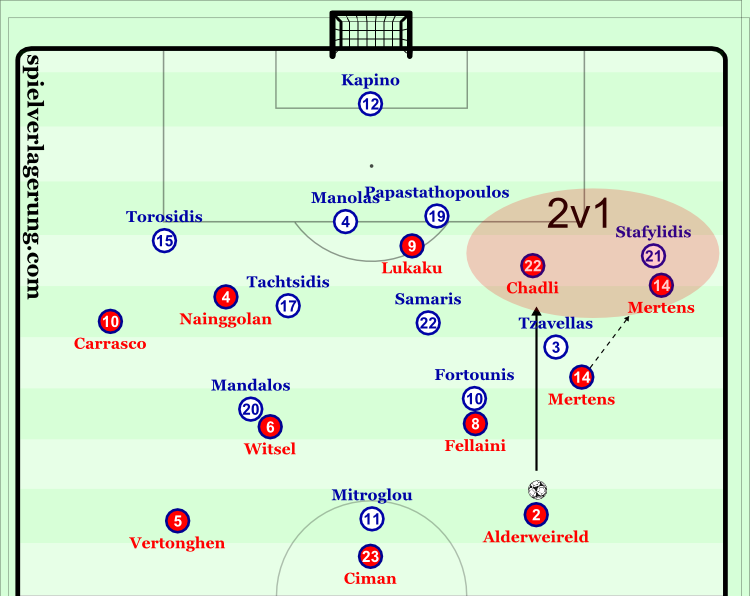
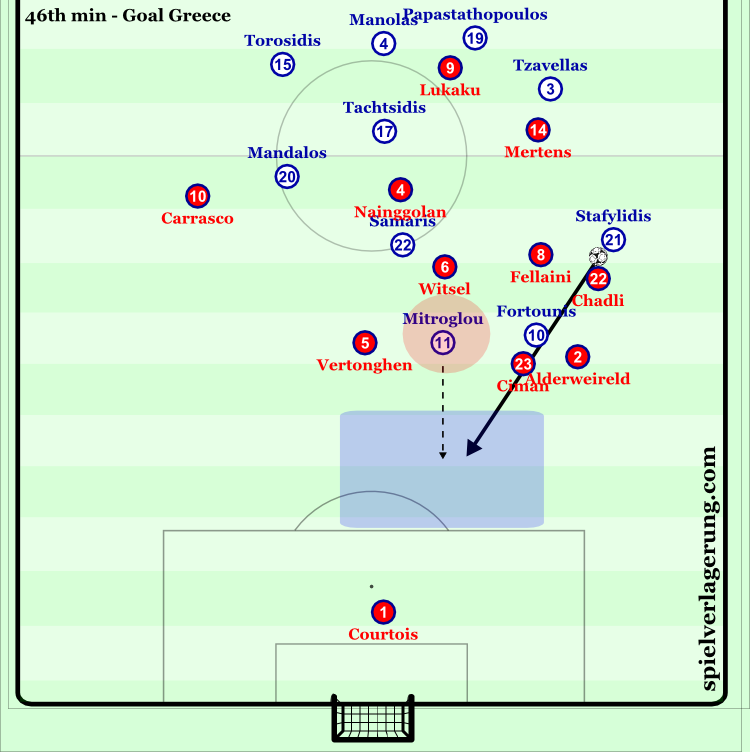
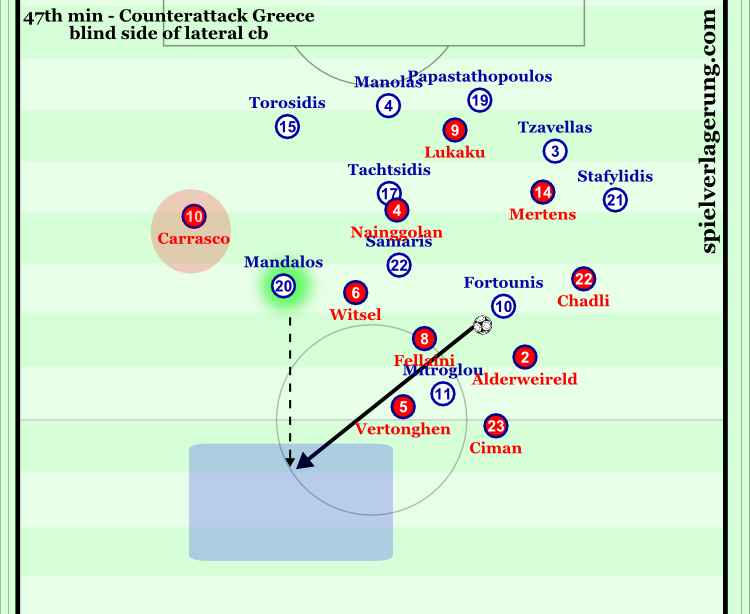
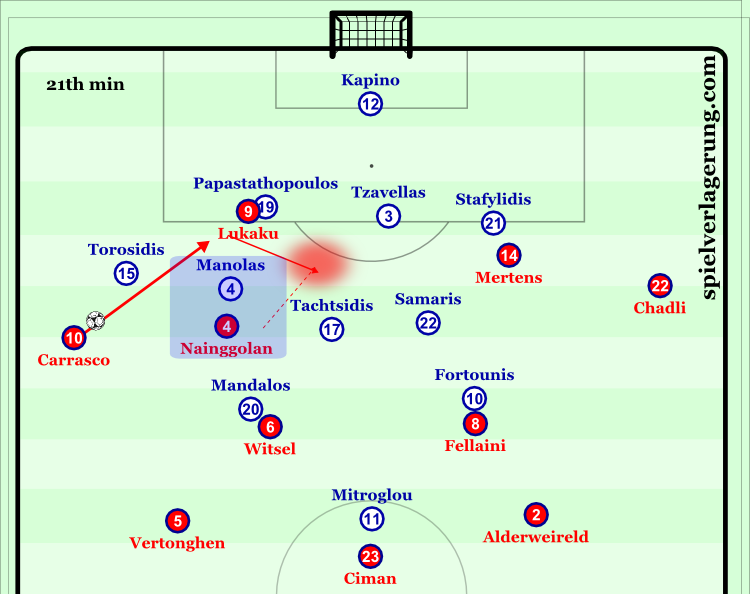
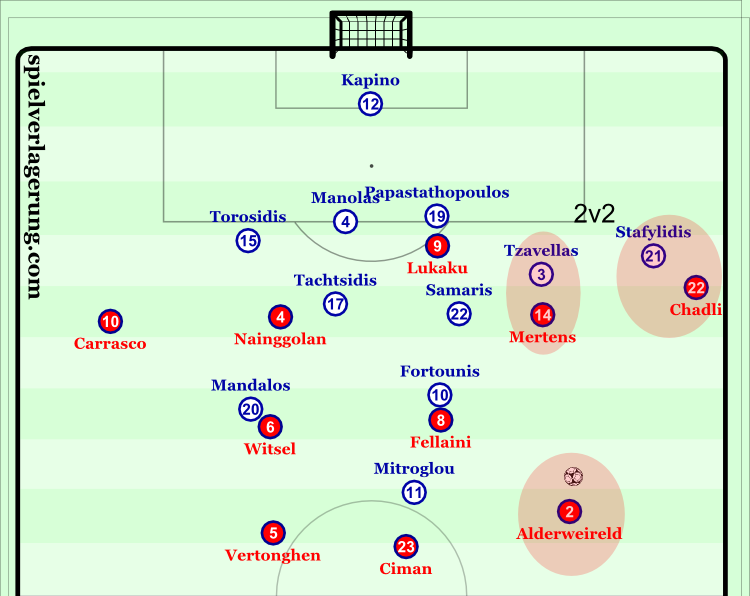
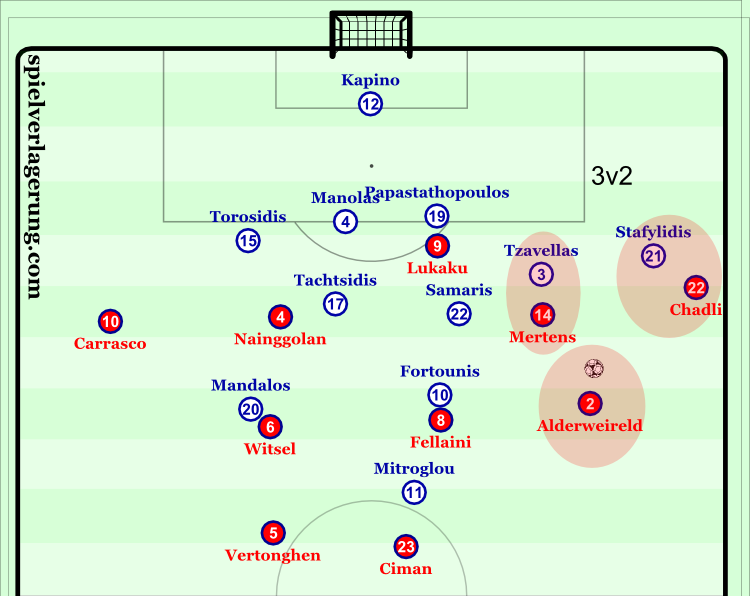
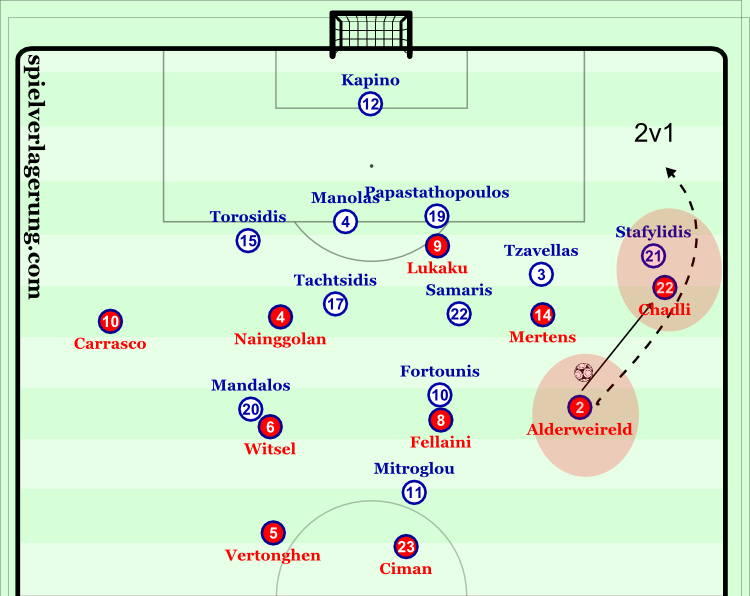
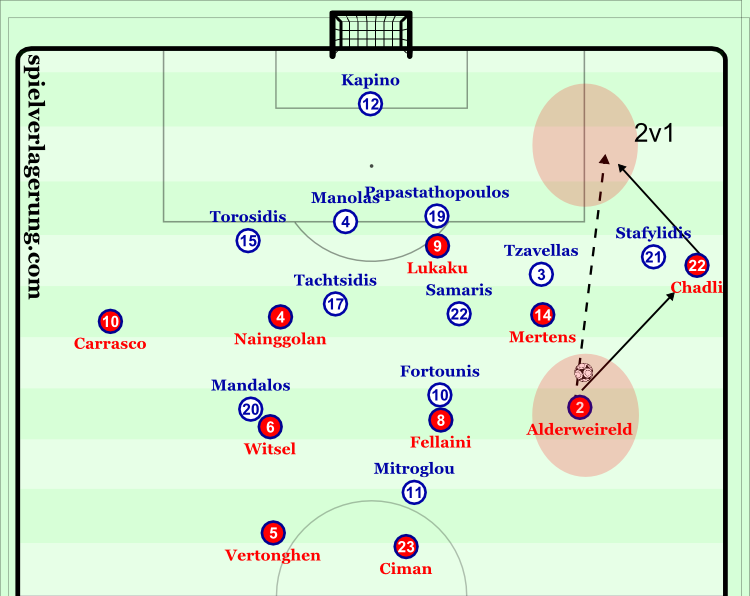
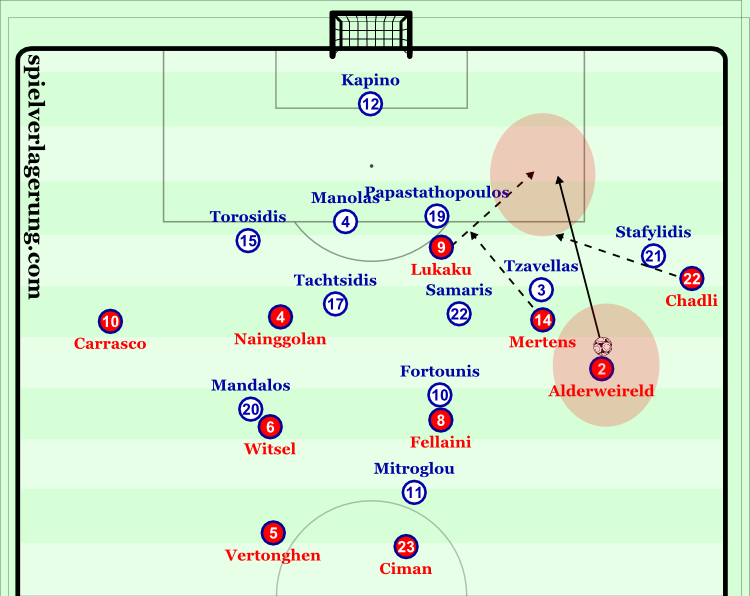
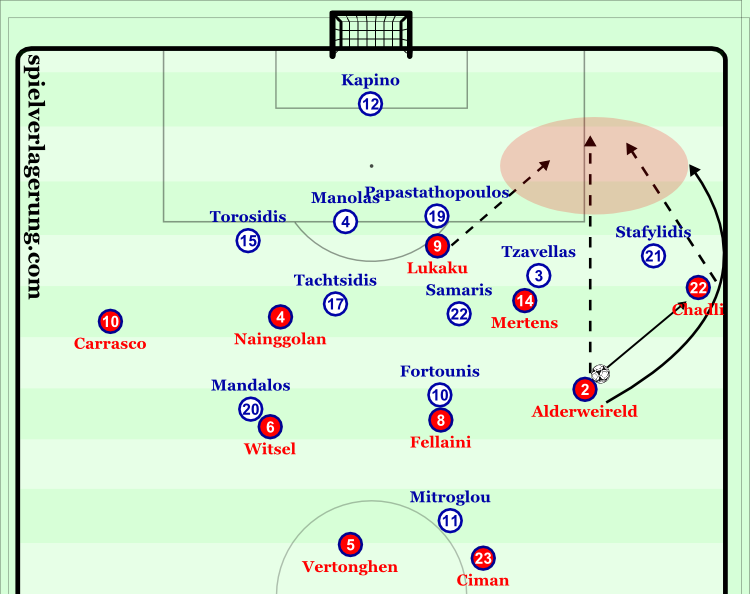
Keine Kommentare vorhanden Alle anzeigen